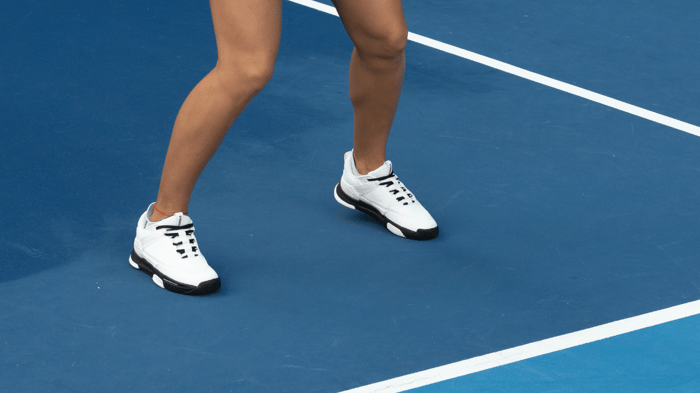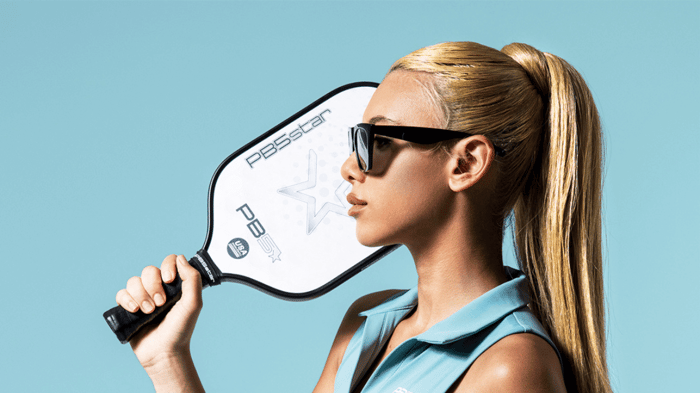Has a game-changing error like a foot fault ever cost you a crucial point in pickleball? This often overlooked rule violation can significantly impact your game.
In pickleball, an illegal foot placement occurs when a player's foot touches or crosses a restricted area during key moments, such as serving or approaching the non-volley zone. Recognizing and avoiding these infractions is essential for maintaining fair play and competitive edge, as they can result in lost serves or points.
Perfecting your footwork not only helps you steer clear of rule violations but also elevates your overall performance on the court. By honing your foot placement and movement, you'll develop superior control, agility, and confidence in your gameplay.
At PB5star, we're passionate about helping you reach new heights in your pickleball journey. Our high-quality gear is designed to boost your performance and style on the court. Join the PB5star community and take your pickleball game to new heights!
What is a foot fault in pickleball? Breaking down the rules
Foot faults in pickleball occur when a player's foot touches or crosses a restricted area during key moments of play. These boundary breaches are governed by specific rules set by the USA Pickleball Association.
For servers, a foot fault happens when their feet touch any part of the court, including the baseline, at the moment of striking the ball. The server must keep both feet behind the baseline until contact is made with the ball. As noted in our serving guide, the server sends the ball diagonally across the court to the opponent's right side.
Receivers face different foot fault rules. While they have more freedom in their positioning, they must still be cautious near the non-volley zone. This area, affectionately known as "the kitchen," extends 7 feet from the net on both sides of the court. Players commit a foot fault if they step into or touch the kitchen while volleying the ball or if their momentum carries them into this area after a volley.
Committing a foot fault results in a loss of serve for the serving team or a point awarded to the serving team if the receiving team commits the fault. According to Prime Time Pickleball, foot faults are among the four common faults players should avoid. Mastering these rules and practicing proper footwork can significantly elevate your game, allowing you to focus on the sheer joy of playing and connecting with your pickleball community.
Types of foot faults in pickleball
Pickleball players need to be aware of various foot faults that can occur during a game. The two primary categories are service foot faults and non-volley zone foot faults.
Service foot faults happen when the server's feet are not positioned correctly at the moment of striking the ball. This includes touching the baseline or stepping into the court before making contact with the ball. As noted in our serving guide, proper foot placement is crucial for a legal serve.
Non-volley zone foot faults occur when a player touches or enters the kitchen area while volleying the ball or if their momentum carries them into this zone after a volley. The kitchen is a key area to watch your feet, as many players get caught up in the excitement of a rapid exchange at the net.
Other less common types include touching the sidelines during serve reception or stepping on the wrong side of the centerline during serve.
Understanding these types of foot faults is not just about avoiding avoidable faults; it's about elevating your game and fostering fair play within our vibrant pickleball community. When you're confident in your footwork, you can focus on the thrill of the rally and the joy of connecting with your fellow players.
Examples of foot faults in pickleball
Understanding common foot fault scenarios can help you and your pickleball buddies enjoy fairer, more exciting games. Let's explore some real-game examples that will sharpen your awareness and elevate your play:
Baseline overstepping: A server's foot touches or crosses the baseline while striking the ball, resulting in an immediate fault.
Non-volley zone contact: A player's foot touches the kitchen while executing a volley, often occurring during fast-paced net exchanges.
Momentum fault: After a volley, a player's forward momentum carries them into the kitchen, resulting in a fault as per USA Pickleball rules.
Sideline touch during reception: A receiving player's foot contacts the sideline while awaiting the serve, an often overlooked positioning error.
Incorrect serving position: A server accidentally stands on the wrong side of the centerline, leading to a foot fault before the serve begins.
By mastering these nuances together, we create a more enjoyable and competitive environment for all players. Remember, pickleball is about continuous learning and shared experiences on the court. As you work on perfecting your footwork, keep an eye out for PB5star's upcoming footwear line, designed to enhance your game and help you glide across the court with confidence.
Common questions about foot faults
Curious about foot faults? Let's tackle some frequently asked questions to help you play within the pickleball foot fault rules and keep your game sharp.
Can I step on the baseline during a serve?
Keep those toes in check! Your feet must remain behind the baseline until you make contact with the ball during a serve. According to the Official Rulebook for USA Pickleball, even a toe on the line counts as a fault. Try placing a small marker behind the baseline during practice to help you visualize your ideal serving position.
Are foot faults called differently in recreational vs. competitive play?
While the rules are the same, enforcement might be more relaxed in casual games. Challenge yourself to stick to the rules, even in friendly matches. Your pickleball buddies will appreciate your commitment to fair play, and you'll be tournament-ready when the time comes!
How can I avoid foot faults during intense rallies?
It's all about muscle memory. Try this drill: place pool noodles or rope along the kitchen line and practice your dinks and volleys without touching them. This visual cue will help you internalize the boundary, making it second nature during gameplay.
Do I need special shoes to avoid foot faults?
While specific shoes aren't required, proper footwear can boost your control and quick movements. Look for shoes with good lateral support and non-marking soles. And keep an eye out for PB5star's upcoming footwear line – we're designing shoes to help you dominate the court with style and precision!
Any tips for maintaining proper positioning throughout a game?
Absolutely! Try the "reset routine" – after each point, consciously reset your position on the court. This quick mental check can prevent creeping too close to restricted areas. Also, communicate with your partner about court coverage to avoid unnecessary scrambling that might lead to foot faults.
By mastering these aspects of the game, you'll not only sidestep penalties but also elevate your overall performance. Remember, pickleball is about growing together and having a blast on the court. So keep refining those skills, stay aware of your positioning, and most importantly, enjoy every moment with your pickleball community!
Pro tips to avoid foot faults in pickleball
Mastering your footwork is crucial for elevating your pickleball game and steering clear of troublesome foot faults. Here are some practical tips to keep you on the right side of the line:
Perfect your serve stance: Set up markers behind the baseline during practice to reinforce proper foot placement. This visual cue will help build muscle memory for legal serves.
Implement a "reset routine": After each point, consciously reposition yourself on the court. This quick mental check prevents inadvertently moving too close to restricted areas like the kitchen.
Coordinate with your partner: Establish clear court coverage with your teammate to avoid unnecessary rapid movements that might lead to foot faults. Effective communication is key to successful doubles play.
Enhance balance and stability: Consider using specialized insoles to improve your on-court stability. Better stability can help prevent accidental steps into restricted areas.
Invest in high-performance footwear: While anticipating PB5star's soon-to-be-released shoe collection, look for footwear with excellent lateral support and non-marking soles. The right shoes can significantly improve your control and agility on the court.
By incorporating these tips into your pickleball routine, you'll not only avoid foot faults but also enhance your overall performance. Remember, every step you take on the court is an opportunity to refine your skills and push your limits. Stay tuned for updates on PB5star's new shoes, meticulously crafted for unparalleled court control and designed to help you glide across the court with confidence and style!
Take your game to the next level with PB5star
Mastering foot placement in pickleball is a game-changer, enhancing both your performance and enjoyment on the court. As we grow together in this vibrant pickleball community, from serve to kitchen play, every step counts. Our high-performance apparel is crafted to boost your confidence and comfort, allowing you to focus on what really matters - the thrill of the game.
Amplify your court presence by joining the PB5star family. Gain exclusive access to premium products, expert insights, and connect with fellow enthusiasts who share your passion. We're committed to supporting your pickleball journey, offering resources to refine your skills and enhance your gameplay. Visit PB5star for more game-improving articles, and stay tuned for our upcoming footwear line - designed to help you master your footwork and play with precision. Let's elevate our pickleball experience together!







